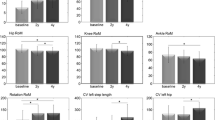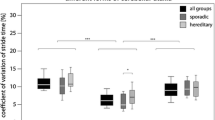Abstract
Our aim was to perform a comprehensive analysis of the global and segmental features of gait in patients with genetically confirmed inherited ataxias. Sixteen patients with autosomal dominant (spinocerebellar ataxia, SCA1 or 2) or recessive (Friedreich’s ataxia, FRDA) ataxia were studied. We used a motion analysis system to record gait kinematic and kinetic data. We measured the mean values of global (time–distance parameters, COM displacement, support moment) and segmental gait parameters (joint displacement and inter-joint coordination), as both discrete and continuous variables, and their variability and correlations with International Cooperative Ataxia Rating Scale (ICARS) scores. We found a marked difference in all global gait parameters between the ataxic patients and the controls and close correlations between longer stride and stance duration and lower gait, posture and total ICARS scores. The only difference between the two patient groups was a shorter step length in the FRDA patients. As regards the segmental features, we found a significantly different waveform shape for all continuous kinematic and kinetic measures between the ataxic patients and the healthy controls, but only minor differences for the discrete measures. Intersegmental coordination evaluated using the continuous relative phase method revealed an irregular alternating joint behaviour without clear evidence of the synchronous pattern of alternating proximal/distal joint seen in healthy subjects. For almost all gait parameters we observed a markedly higher intra-subject variability in the ataxic patients versus the controls, which was strongly related to the clinical ICARS scores. Patients with chronic, progressive inherited ataxias lose the ability to “stabilize” a walking pattern that can be repeated over time. The most peculiar aspect of the gait of inherited ataxia patients, regardless the different genetic forms, seems to be the presence of increased variability of all global and segmental parameters rather than an invariant abnormal gait pattern.






Similar content being viewed by others
References
Holmes G. The cerebellum of man. Brain. 1939;62:1–30.
Hallett M, Massaquoi SG. Physiologic studies of dysmetria in patients with cerebellar deficits. Can J Neurol Sci. 1993;20:S83–92.
Diener HC, Dichgans J, Bacher M, Gompf B. Quantification of postural sway in normals and patients with cerebellar diseases. Electroencephalogr Clin Neurophysiol. 1984;57:134–42.
Morton SM, Bastian AJ. Cerebellar control of balance and locomotion. Neuroscientist. 2004;10:247–59.
Schöls L, Bauer P, Schmidt T, Schulte T, Riess O. Autosomal dominant cerebellar ataxias: clinical features, genetics, and pathogenesis. Lancet Neurol. 2004;3:291–304.
Wilson CL, Fahey MC, Corben LA, Collins VR, Churchyard AJ, Lamont PJ, et al. Quality of life in Friedreich ataxia: what clinical, social and demographic factors are important? Eur J Neurol. 2007;14:1040–7.
Fogel BL, Perlman S. Clinical features and molecular genetics of autosomal recessive cerebellar ataxias. Lancet Neurol. 2007;6:245–57.
Palliyath S, Hallett M, Thomas SL, Lebiedowska MK. Gait in patients with cerebellar ataxia. Mov Disord. 1998;13:958–64.
Hudson CC, Krebs DE. Frontal plane dynamic stability and coordination in subjects with cerebellar degeneration. Exp Brain Res. 2000;132:103–13.
Ebersbach G, Sojer M, Valldeoriola F, Wissel J, Muller J, Tolosa E, et al. Comparative analysis of gait in Parkinson’s disease, cerebellar ataxia and subcortical arteriosclerotic encephalopathy. Brain. 1999;122:1349–55.
Mitoma H, Hayashi R, Yanagisawa N, Tsukagoshi H. Characteristics of parkinsonian and ataxic gaits: a study using surface electromyograms, angular displacements and floor reaction forces. J Neurol Sci. 2000;174:22–39.
Stolze H, Klebe S, Petersen G, Raethjen J, Wenzelburger R, Witt K, et al. Typical features of cerebellar ataxic gait. J Neurol Neurosurg Psychiatry. 2002;73:310–2.
Morton SM, Bastian AJ. Relative contributions of balance and voluntary leg-coordination deficits to cerebellar gait ataxia. J Neurophysiol. 2003;89:1844–56.
Earhart GM, Bastian AJ. Selection and coordination of human locomotor forms following cerebellar damage. J Neurophysiol. 2001;85:759–69.
Ilg W, Golla H, Thier P, Giese MA. Specific influences of cerebellar dysfunctions on gait. Brain. 2007;130:786–8.
Ilg W, Giese MA, Gizewski ER, Schoch B, Timmann D. The influence of focal cerebellar lesions on the control and adaptation of gait. Brain. 2008;131:2913–27.
Crowdy KA, Hollands MA, Ferguson IT, Marple-Horvat DE. Evidence for interactive locomotor and oculomotor deficits in cerebellar patients during visually guided stepping. Exp Brain Res. 2000;135:437–54.
Trouillas P, Takayanagi T, Hallett M, et al. International Cooperative Ataxia Rating Scale for pharmacological assessment of the cerebellar syndrome. The Ataxia Neuropharmacology Committee of the World Federation of Neurology. J Neurol Sci. 1997;145:205–11.
Ferrigno G, Pedotti A. ELITE: a digital dedicated hardware system for movement analysis via real-time TV signal processing. IEEE Trans Biomed Eng. 1985;32:943–50.
Winter DA. Biomechanics of human movement. New York. Wiley, 1990.
Davis RB, Ounpuu S, Tyburski D, Gage JR. A gait analysis data collection and reduction technique. Hum Movement Sci. 1991;10:575–87.
Gutierrez-Farewik EM, Bartonek A, Saraste H. Comparison and evaluation of two common methods to measure center of mass displacement in three dimensions during gait. Hum Movement Sci. 2006;25:238–56.
Perry J. Movement analysis. Normal and pathological function. New Jersey: SLACK Incorporated. Elsevier; 1992.
Hof AL. On the interpretation of the support moment. Gait Posture. 2000;12:196–9.
DeVita P, Lassiter Jr T, Hortobagyi T, Torry M. Functional knee brace effects during walking in patients with anterior cruciate ligament reconstruction. Am J Sports Med. 1998;26:778–84.
Vaughan CL, Davis BL, O’Connor JC. Dynamics of human gait. 2nd Ed. South Africa: Kiboho Publishers; 1999.
Kelso JA. Phase transitions and critical behavior in human bimanual coordination. Am J Physiol. 1984;246:R1000–4.
Haken H, Kelso JA, Bunz H. A theoretical model of phase transitions in human hand movements. Biol Cybern. 1985;51:347–56.
Hamill J, van Emmerik RE, Heiderscheit BC, Li L. A dynamical systems approach to lower extremity running injuries. Clin Biomech (Bristol, Avon). 1999;14:297–308.
Stergiou N, Jensen JL, Bates BT, Scholten SD, Tzetzis G. A dynamical systems investigation of lower extremity coordination during running over obstacles. Clin Biomech (Bristol, Avon). 2001;16:213–21.
Li L, Van Den Bogert ECH, Caldwell GE, Van Emmerick REA, Hamill J. Coordination patterns of walking and running at similar speed and stride frequency. Hum Mov Sci. 1999;8:67–85.
Kabada MP, Ramakrishnan ME, Gainey WJ, Gorton G, Cochran GVB. Reproducibility of kinematic, kinetic, and electromyographic data in normal adult gait. J Orthop Res. 1989;7:849–60.
Gilman S, Bloedel JR, Lechtemberg R. Disorders of the cerebellum. Contemporary Neurology Series. Philadelphia: EA Davis; 1981.
Goodkin HP, Keating JG, Martin TA, Thach WT. Preserved simple and impaired compound movement after infarction in the territory of the superior cerebellar artery. Can J Neurol Sci. 1993;20((Suppl)3):S93–104.
Goodkin HP, Thach WT. Cerebellar control of constrained and unconstrained movements: II. EMG and nuclear activity. J Neurophysiol. 2003;89:896–908.
Bastian AJ, Martin TA, Keating JG, Thach WT. Cerebellar ataxia: abnormal control of interaction torques across multiple joints. J Neurophysiol. 1996;76:492–509.
Bastian AJ, Zackowski KM, Thach WT. Cerebellar ataxia: torque deficiency or torque mismatch between joints? J Neurophysiol. 2000;83:3019–30.
Thach WT, Goodkin HP, Keating JG. The cerebellum and the adaptive coordination of movement. Annu Rev Neurosci. 1992;15:403–42.
Hausdorff JM. Stride variability: beyond length and frequency. Gait Posture. 2004;20:304.
Barak Y, Wagenaar RC, Holt KG. Gait characteristics of elderly people with a history of falls: a dynamic approach. Phys Ther. 2006;86:1501–10.
Hollman JH, Kovash FM, Kubik JJ, Linbo RA. Age-related differences in spatiotemporal markers of gait stability during dual task walking. Gait Posture. 2007;26:113–9.
Hausdorff JM, Cudkowicz ME, Firtion R, Wei JY, Goldberger AL. Gait variability and basal ganglia disorders: stride-to-stride variations of gait cycle timing in Parkinson’s disease and Huntington’s disease. Mov Disord. 1998;13:428–37.
Webster KE, Merory JR, Wittwer JE. Gait variability in community dwelling adults with Alzheimer disease. Alzheimer Dis Assoc Disord. 2006;20:37–40.
Conflict of Interest
The authors declare that there are no financial or other relationships that might lead to a conflict of interest(s).
Author information
Authors and Affiliations
Corresponding author
Rights and permissions
About this article
Cite this article
Serrao, M., Pierelli, F., Ranavolo, A. et al. Gait Pattern in Inherited Cerebellar Ataxias. Cerebellum 11, 194–211 (2012). https://doi.org/10.1007/s12311-011-0296-8
Published:
Issue Date:
DOI: https://doi.org/10.1007/s12311-011-0296-8




